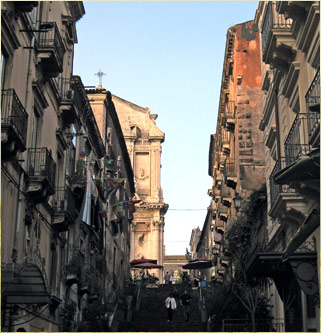|
In the southeastern corner of Sicily sits Siracusa, a coastal town famous for its ancient architecture and friendly people. Designated a UNESCO World Heritage Site in 2005, Siracusa is a “must-see” for ancient history buffs. After being founded in 734 BC by Greek settlers from Corinth, the city’s power was soon seized by a succession of tyrants. Under their rule, Siracusa grew quickly and became so large and powerful that it rivaled Athens. Home to such great men as Archimedes, Pindar and Aeschylus, Siracusa was considered the most important city in Magna Graecia (Greater Greece). What makes it such a fascinating place for visitors today is that Siracusa is full of remnants from the many foreign armies that conquered it over the years, including Carthage, the Arabs, the Byzantines, the Normans and the Spanish, to name a few. After you’ve checked out all of the spectacular ruins on the mainland, you’ll want to head to the charming island of Ortigia (or Ortygia), the oldest part of Siracusa. Wander through the narrow medieval streets taking in not only Ortigia’s archaeological sites, but its cute boutiques and cafes as well. Cicero once proclaimed that Siracusa was “the greatest Greek city and the most beautiful of them all.” Come see for yourself.
|
|
Some of Siracusa’s most important attractions are located in the city’s archaeological park, Neapolis Parco Archeologico. A couple of them are listed below.
Greek Theater
Tragedies have been staged in this theater since the 5th century BC. Carved almost entirely out of rock, the theater’s cavea is one of the largest ever built by the ancient Greeks. While most of the ancient seats have been eaten away by time, the Italian Institute of Ancient Drama continues to present classical Greek and Roman dramas today, usually in Italian.
Latomia del Paradiso
The most famous of the limestone quarries in this area, run by the Greeks, was hardly paradise for the prisoners who spent their lives there cutting limestone and dreaming of escape. Within the quarry is the Orecchio di Dionisio (Ear of Dionysius). This grotto is named as such because it is shaped like an “s” and has extremely good acoustics, which made it easy for Dionysius, a tyrant king, to eavesdrop on his captives listening for whispers of insurrection.
The historic center of Siracusa, Ortigia, is a charming little island that can be reached by crossing the Ponte Nuovo (New Bridge). Sites to see in the Città Vecchia (Old City), as is often called, include:
Fonte Arethusa
This freshwater spring is located on Ortygia island. According to Greek mythology, Arethusa took shelter here to escape the river god Alpheus, who had fallen in love with the sea nymph and was hunting her down. When Arethusa called upon the goddess Artemis to rescue her, Artemis responded by transforming her into spring.
Duomo di Siracusa
This Cathedral of Syracuse was erected in the 7th century over the great Temple of Athens, which was a Doric temple, dating back to the 5th century BC, that honored Athena. The Duomo is an amazing structure as its design was influenced by several different cultures including Greek, Byzantine, Arabic and Norman. After the earthquake in 1693, the main façade was rebuilt in the Baroque style.
Ortigia Market
Be sure to visit this colorful outdoor market, renowned for its exquisite fresh fruits, vegetables and seafood.
|



